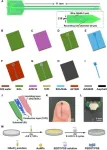(Press-News.org) Transgender women are still at risk for prostate cancer. A new study led by Cedars-Sinai Cancer investigators, published in the peer-reviewed Journal of the American Medical Association, concludes that current screening guidelines could miss early-stage prostate cancer in transgender women on hormone therapy.
The prostate, a small gland that helps make semen, also produces a protein called prostate-specific antigen, or PSA. Blood levels of PSA tend to be elevated in people who have prostate cancer, and the PSA test, which measures those levels, is a common prostate cancer screening tool.
“Many transgender women take estrogen as part of their gender-affirming care,” said Stephen Freedland, MD, the Warschaw, Robertson, Law Families Chair in Prostate Cancer at Cedars-Sinai and senior author of the study. “This drastically lowers PSA levels, which could mean the threshold we are using as ‘normal’ is too high to detect early-stage cancer in these patients. We undertook this study to determine typical PSA values for this population so that we can screen them more appropriately.”
According to current guidelines, PSA levels above 4.0 nanograms per milliliter of blood (ng/mL) suggest cancer could be present, and that additional investigation, such as a prostate biopsy, is needed.
"In the study, we used Veterans Health Administration records to identify 210 transgender women without known prostate cancer who were taking estrogen,” said Farnoosh Nik-Ahd, MD, a urology resident at the University of California, San Francisco, and first author of the study. “We found that the median PSA value, the midpoint in the range of participants, was 0.02 ng/mL, which is fiftyfold lower than PSA values reported in similar-aged cisgender men.”
This suggests that if they are taking estrogen, transgender women who develop prostate cancer wouldn’t see their PSA rise to levels that trigger additional screening until their cancer was at a later stage, making it more difficult to treat. Nik-Ahd said that patients and clinicians should be aware of this and interpret results with caution.
“Cedars-Sinai Cancer serves one of the most diverse patient populations in the country,” said Dan Theodorescu, MD, PhD, director of Cedars-Sinai Cancer and the PHASE ONE Foundation Distinguished Chair. “This work is part of our mission to conduct research that helps us understand the unique needs of our patients, then translate our findings into practices that improve patient outcomes.”
Additional research is needed to pinpoint a specific PSA level that indicates a transgender woman taking estrogen is at high risk for developing prostate cancer. And Freedland, who is also a professor of Urology at Cedars-Sinai and staff physician at the Durham VA Medical Center in North Carolina, said this study is not a call for transgender women to be screened.
“We know that PSA screening reduces the risk that cisgender men ages 55 to 69 will die of prostate cancer, but we don’t know that it does the same thing for transgender women taking estrogen,” Freedland said. “However, because some of these women are being screened, we want to raise awareness that their typical PSA levels are different.”
Along with increased awareness, Freedland hopes to eventually see updated PSA screening guidelines. In the meantime, he advises transgender women who are taking estrogen to consult with their healthcare providers.
“Don't forget that you have a prostate and that prostates can become cancerous,” Freedland said. “The best way we know to find those cancers early and reduce the risk of death is a PSA test. And if you choose to do that, keep in mind that the test values are not calibrated for you. Bring your results—and possibly this study—to your urologist so that your results will be interpreted by someone who understands what to do with that information.”
Funding: Research reported in this publication was supported by NIA grant number R38AG07017, the 2023 Urology Care Foundation Residency Research Award Program, and the Robert J. Krane, MD, Urology Research Fund.
Additional authors include: Amanda M. De Hoedt, MS; Christi Butler, MD; Jennifer T. Anger, MD; Peter R. Carroll, MD, MPH; and Matthew R. Cooperberg, MD, MPH.
END
Improving prostate cancer screening for transgender women
Cedars-Sinai study finds PSA tests may give false reassurance for transgender women on estrogen therapy and could miss some cancers
2024-06-26
ELSE PRESS RELEASES FROM THIS DATE:
For healthy adults, taking multivitamins daily is not associated with a lower risk of death
2024-06-26
What: A large analysis of data from nearly 400,000 healthy U.S. adults followed for more than 20 years has found no association between regular multivitamin use and lower risk of death. The study, led by researchers at the National Institutes of Health’s National Cancer Institute, was published June 26, 2024, in JAMA Network Open.
Many adults in the United States take multivitamins with the hope of improving their health. However, the benefits and harms of regular multivitamin use remain unclear. ...
From takeoff to flight, the wiring of a fly's nervous system is mapped
2024-06-26
Work is underway on a wiring diagram of the motor circuits in the central nervous system that control muscles in fruit flies. This connectome, as the wiring diagram is called, is already providing detailed information on how the nerve coordination of leg movements differs from that controlling the wings.
Although fruit flies seem like simple creatures, the researchers said that their motor system contains “an unexpected level of complexity.”
“A typical fly motor neuron receives thousands of synapses from hundreds ...
A chip-scale Titanium-sapphire laser
2024-06-26
As lasers go, those made of Titanium-sapphire (Ti:sapphire) are considered to have “unmatched” performance. They are indispensable in many fields, including cutting-edge quantum optics, spectroscopy, and neuroscience. But that performance comes at a steep price. Ti:sapphire lasers are big, on the order of cubic feet in volume. They are expensive, costing hundreds of thousands of dollars each. And they require other high-powered lasers, themselves costing $30,000 each, to supply them with enough energy to function.
As a result, Ti:sapphire lasers ...
El Niño forecasts extended to 18 months with innovative physics-based model
2024-06-26
Across Asia, the Pacific Ocean, and the Americas, El Niño Southern Oscillation (ENSO) brings variations in winds, weather, and ocean temperature that can cause droughts, floods, crop failures, and food shortages. Recently, the world has experienced a major El Niño event in 2023-2024, dramatically impacting weather, climate, ecosystems, and economies globally. By developing an innovative modeling approach, researchers from the School of Ocean and Earth Science and Technology (SOEST) at the University ...
Scientists discover genetic ‘off switch’ in legume plants that limits biological ability to source nutrients
2024-06-26
A genetic “off switch” that shuts down the process in which legume plants convert atmospheric nitrogen into nutrients has been identified for the first time by a team of international scientists.
Legumes like beans, peas and lentils are unique among crops for their ability to interact with soil bacteria to convert or “fix” nitrogen into a usable form of nutrients. However, this energy-intensive biological process is reduced when nitrogen is already abundant in the soil either through natural processes or through the application of synthetic ...
The Frontiers Planet Prize announces 2024 International Champions
2024-06-26
The Frontiers Planet Prize today (26 June) announced its 2024 International Champions. The Prize recognizes and rewards scientists whose groundbreaking research accelerates solutions to help humanity remain safely within the nine planetary boundaries. The three winning scientists, Dr Pedro Jaureguiberry, Instituto Multidisciplinario de Biología Vegetal (Argentina), Prof Dr Peter Haase, Senckenberg Society for Nature Research (Germany), and Prof Jason Rohr, University of Notre Dame (USA), were each awarded 1.1 million (USD) / 1 million (CHF) to support their research.
The International Champions award-winning research ...
Precision instrument bolsters efforts to find elusive dark energy
2024-06-26
Dark energy — a mysterious force pushing the universe apart at an ever-increasing rate — was discovered 26 years ago, and ever since, scientists have been searching for a new and exotic particle causing the expansion.
Pushing the boundaries of this search, University of California, Berkeley physicists have now built the most precise experiment yet to look for minor deviations from the accepted theory of gravity that could be evidence for such a particle, which theorists have dubbed a chameleon or symmetron.
The experiment, which combines an atom interferometer for precise gravity ...
Overcoming challenges encountered by Spanish-speaking trauma patients
2024-06-26
Key Takeaways
Spanish-speaking patients who suffer traumatic injuries face gaps in their care once they leave the hospital, many with a high need for mental health services.
More than half of the patients studied reported food insecurity, transportation challenges, and needing help with utilities.
A novel care pathway developed by researchers can help connect these patients with needed services.
CHICAGO – Many trauma patients face a myriad of challenges when recovering from a traumatic injury, ...
Every walk you take: Promoting active and healthy ageing of citizens
2024-06-26
Promoting active and healthy ageing of citizens through a new mobile application that shows walking routes through green areas in Barcelona with data on geolocation, obstacles, pollution and weather in real time: this is the aim of the citizen science project Every Walk You Take, promoted by a team from the University of Barcelona. This initiative aims to promote physical activity and health among the over-fifty-five population through a new mobile-assisted health intervention (mHealth).
This innovative app, presented in an article published in Sustainability ...
Innovative research unveils link between depression and amygdala activity in rats
2024-06-26
A significant new study published in the Cyborg Bionic Systems journal by Fanli Kong and colleagues sheds light on the intricate relationship between depression and brain activity, particularly focusing on the basolateral amygdala (BLA) in rats. This research offers compelling insights into how depression can alter neural circuits and could pave the way for new treatments.
Depression is a debilitating mental health issue affecting millions worldwide and is known for symptoms like persistent sadness, loss of interest in enjoyable activities, and fatigue. While traditional treatments have focused on neurotransmitters in the brain, this study dives deeper into the brain’s structural ...
LAST 30 PRESS RELEASES:
Can community awareness campaigns in low-resource areas improve early diagnosis of colorectal cancer?
Stardust study resets how life’s atoms spread through space
Practical education: Clinical scenario-based program development
The impact of family dynamics on eating behaviour – how going home for Christmas can change how you eat
Tracing the quick synthesis of an industrially important catalyst
New software sheds light on cancer’s hidden genetic networks
UT Health San Antonio awarded $3 million in CPRIT grants to bolster cancer research and prevention efforts in South Texas
Third symposium spotlights global challenge of new contaminants in China’s fight against pollution
From straw to soil harmony: International team reveals how biochar supercharges carbon-smart farming
Myeloma: How AI is redrawing the map of cancer care
Manhattan E. Charurat, Ph.D., MHS invested as the Homer and Martha Gudelsky Distinguished Professor in Medicine at the University of Maryland School of Medicine
Insilico Medicine’s Pharma.AI Q4 Winter Launch Recap: Revolutionizing drug discovery with cutting-edge AI innovations, accelerating the path to pharmaceutical superintelligence
Nanoplastics have diet-dependent impacts on digestive system health
Brain neuron death occurs throughout life and increases with age, a natural human protein drug may halt neuron death in Alzheimer’s disease
SPIE and CLP announce the recipients of the 2025 Advanced Photonics Young Innovator Award
Lessons from the Caldor Fire’s Christmas Valley ‘Miracle’
Ant societies rose by trading individual protection for collective power
Research reveals how ancient viral DNA shapes early embryonic development
A molecular gatekeeper that controls protein synthesis
New ‘cloaking device’ concept to shield sensitive tech from magnetic fields
Researchers show impact of mountain building and climate change on alpine biodiversity
Study models the transition from Neanderthals to modern humans in Europe
University of Phoenix College of Doctoral Studies releases white paper on AI-driven skilling to reduce burnout and restore worker autonomy
AIs fail at the game of visual “telephone”
The levers for a sustainable food system
Potential changes in US homelessness by ending federal support for housing first programs
Vulnerability of large language models to prompt injection when providing medical advice
Researchers develop new system for high-energy-density, long-life, multi-electron transfer bromine-based flow batteries
Ending federal support for housing first programs could increase U.S. homelessness by 5% in one year, new JAMA study finds
New research uncovers molecular ‘safety switch’ shielding cancers from immune attack
[Press-News.org] Improving prostate cancer screening for transgender womenCedars-Sinai study finds PSA tests may give false reassurance for transgender women on estrogen therapy and could miss some cancers





